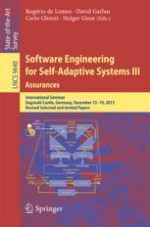A major challenge for modern software systems is to become more cost-effective, while being versatile, flexible, resilient, energy-efficient, customizable, and configurable when reacting to run-time changes that may occur within the system itself, its environment or requirements. One of the most promising approaches to achieving such properties is to equip the software system with self-adaptation capabilities. Despite recent advances in this area, one key aspect that remains to be tackled in depth is the provision of assurances.
Originating from a Dagstuhl seminar held in December 2013, this book constitutes the third volume in the series “Software Engineering for Self-Adaptive Systems”, and looks specifically into the provision of assurances. Opening with an overview chapter on Research Challenges, the book presents 13 further chapters written and carefully reviewed by internationally leading researchers in the field. The book is divided into topical sections on research challenges, evaluation, integration and coordination, and reference architectures and platforms.
